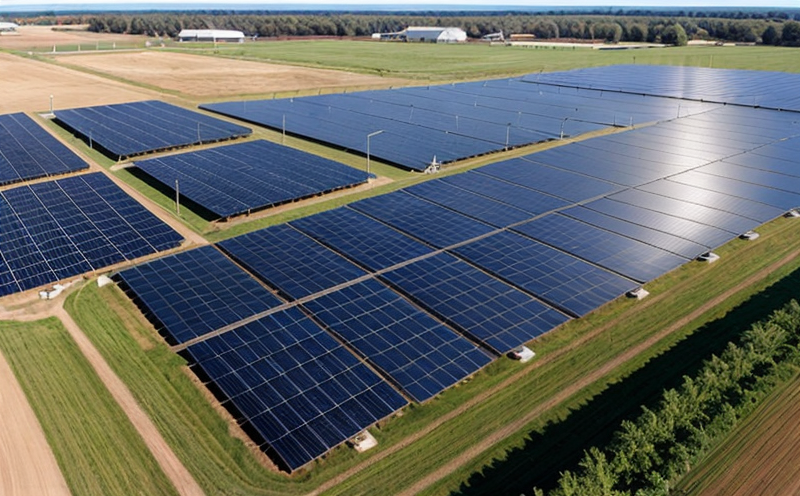IEEE 1547 Interconnection Testing of Emerging Distributed Resources
The IEEE Standard IEEE 1547-2003 with Amendment A, IEEE 1547-2018 is a cornerstone in the interconnection of distributed resources to utility grids. This standard ensures that power generation systems, including emerging renewable technologies such as solar photovoltaic (PV) arrays and energy storage systems (ESS), are safe, reliable, and efficient when connected to distribution networks.
The IEEE 1547 testing is critical for integrating new technologies into existing grid infrastructure without compromising the integrity of the system. The standard covers various aspects including power quality, harmonic content, voltage and frequency regulation, fault ride-through capability, and reactive power management. Understanding these parameters helps in ensuring that new resources can coexist with conventional energy sources.
For emerging distributed resources, the testing process is particularly important as it identifies potential issues such as over-voltages or under-energization during grid disturbances. This ensures compliance with regulatory requirements and enhances public safety by preventing equipment damage or failure due to improper interconnection practices.
The testing procedure typically involves simulating real-world scenarios that a distributed resource might encounter in an operational environment. These include normal operating conditions, as well as fault conditions such as short circuits and ground faults. By subjecting the system to these tests under controlled laboratory settings, engineers can assess how it behaves compared to its rated specifications.
During testing, key parameters are monitored using sophisticated instrumentation capable of capturing detailed data points. This includes voltage levels at various points along the distribution network, current flow through protective devices like circuit breakers and fuses, power factor readings, and harmonic distortion measurements. Additionally, transient events such as sags or swells in voltage can be captured for further analysis.
Once all tests have been completed successfully, a comprehensive report is generated detailing each parameter measured during the course of testing along with any deviations from acceptable limits specified by IEEE 1547 standards. This report serves not only as evidence of compliance but also provides valuable insights into areas where improvements could be made for future iterations of similar technology.
Understanding the intricacies of IEEE 1547 interconnection testing is essential for stakeholders involved in the development and deployment of renewable energy systems. It ensures that these technologies are integrated safely and effectively into existing grid infrastructure, thereby fostering growth within this rapidly evolving sector.
Applied Standards
| Standard Number | Description |
|---|---|
| IEEE 1547-2003 with Amendment A, IEEE 1547-2018 | The standard defines requirements for interconnecting distributed resources to utility grids. It covers aspects such as power quality, harmonic content, voltage and frequency regulation, fault ride-through capability, and reactive power management. |
| IEC 61204-3 | A series of international standards providing guidelines for the electrical characteristics of equipment used in electricity distribution networks. While not directly related to IEEE 1547 interconnection testing, these standards complement each other by offering broader context on grid integration. |
| ASTM G96-03 | An American Society for Testing and Materials standard that specifies methods for determining solar spectral irradiance. Although primarily focused on photovoltaic applications, it supports the overall assessment of performance under different lighting conditions required by IEEE 1547. |
Benefits
The benefits of conducting IEEE 1547 interconnection testing extend beyond mere compliance with regulatory requirements. By ensuring that emerging renewable technologies meet stringent safety and performance criteria, this process fosters trust among consumers who rely on reliable electricity supply.
- Enhanced Grid Reliability: Ensures that interconnected systems do not cause instability in the broader grid structure.
- Better Resource Utilization: Allows for more efficient use of renewable energy sources by optimizing their output during peak demand periods.
- Promotes Innovation: Encourages continuous improvement and development of next-generation technologies that can seamlessly integrate into existing infrastructure.
- Reduces Risk: Minimizes the likelihood of costly repairs or replacements caused by improper installation practices.
In addition to these tangible advantages, IEEE 1547 testing also contributes significantly towards reducing greenhouse gas emissions associated with fossil fuel-based power generation. By promoting cleaner alternatives like solar PV and ESS systems, this standard plays a crucial role in the global transition towards sustainable energy solutions.
Quality and Reliability Assurance
- Comprehensive Monitoring: Utilization of advanced measurement tools to continuously track critical parameters throughout testing.
- Precision Calibration: Regular verification of test equipment against internationally recognized standards to ensure accuracy.
- Data Validation: Cross-referencing results obtained from different instruments for consistency and reliability.
- Repeatable Results: Implementation of standardized procedures to guarantee consistent outcomes across multiple trials.
The commitment to quality assurance throughout the testing process ensures that every aspect of emerging distributed resources is thoroughly evaluated. This approach not only enhances customer satisfaction but also supports continuous improvement efforts aimed at advancing technological capabilities within this dynamic field.





